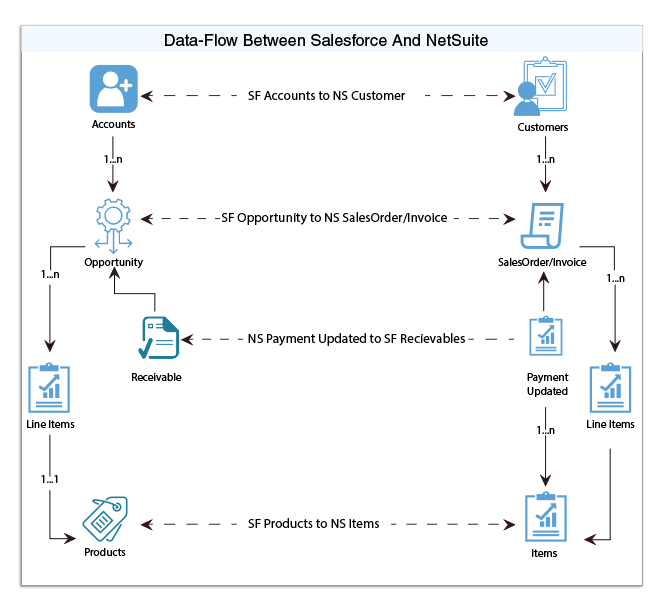2022
Overview
DBSync for Salesforce & NetSuite Integration is an easy to use application to integrate Salesforce Accounts, Products, Opportunity with NetSuite customers, Items and Invoices. DBSync is also useful to migrate historical QuickBooks data into Salesforce or vice versa. DBSync provides Bi-directional sync with pre-built field to field map along with flexibility for more complex and dynamic mapping capability. DBSync also has an automatic online update, enabling DBSync customers to enjoy all the product updates and features with every new release.
Data Flow
Data flow of Bi-directional integration between Salesforce & NetSuite is shown in the below table.
Process Map
The Process Map of Bi-directional integration between Salesforce & NetSuite is shown in the below image.
Although the template of Salesforce and Netsuite comes as one project , for better explanation the data flow is broken down into two sections which are as follows
- Data-Flow from Salesforce To NetSuite: This section explains the the data flow from salesforce to the Netsuite platform and sensationalized as per entity so that the readers can understand the integration requirement and configure their template without any help from DBSync support teams .
- Account Integration:The customer integration data flow constitute of retrieving data from the account object of salesforce and integrating it with NetSuite as customer
- Product Integration: The product integration data flow constitute of retrieving data from the product object of the salesforce and integrating it NetSuite as items
- opportunity Integration : The opportunity integration data flow constitute of retrieving data from the opportunity objects of salesforce and integrating with NetSuite as invoices.
- Data-Flow from NetSuite To Salesforce:This section explains the the data flow from NetSuite platform to the Salesforce and sensationalized as per entity so that the readers can understand the integration requirement and configure their template without any help from DBSync support teams .
- Customer Integration:The customer integration data flow constitute of retrieving data from NetSuite customers and integrating it with Salesforce as Accounts.
- Item Integration: The item integration data flow constitute of retrieving data from the items of the NetSuite and integrating with the Salesforce as products
- Invoice Integration : The Invoice and its line items integration data flow constitute of retrieving data from the Netsuite and integrating with the Salesforce as opportunity and its line items.
- payments Integration : The payment integration data flow constitute of retrieving data from NetSuite and integrating them with the salesforce as receivables.
Pre-requisites for Integration
- Integration of Salesforce to QB transaction is invoked provided the Generate field in Salesforce Opportunity is selected with the required transaction.
- It is mandatory that SF Opportunity (to be integrated with QB Invoice) is associated with the respective SF Account & also should have Products with Standard Price Book attached to it for DBSync to invoke integration.
Running the Integrations
DBSync integration of SkuVault & QuickBooks can be triggered by
- Using run-now button from process listing page of DBSync.
- Using DBSync Scheduler .
Using Run-Now Buttons From DBSync platform
The user can login to DBSync with his valid credentials and hit the Run-now button from the process listing page or from the workflow listing page .
Using DBSync Scheduler
- Scheduler available in DBSync Account can be used to schedule the integrations and the detail pertaining to DBSync scheduler is available from the link http://help.mydbsync.com/docs/display/dbsync/Scheduler .

